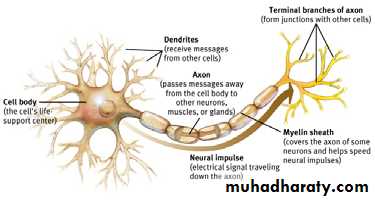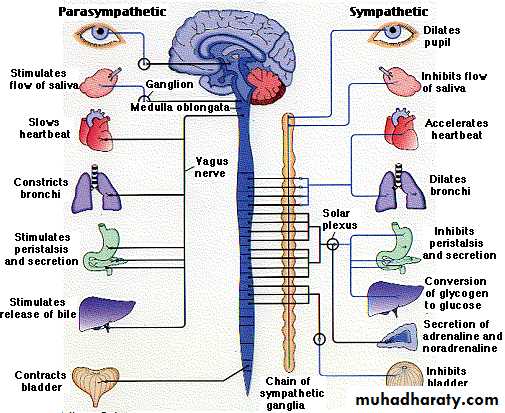Biological basis of behavior
Prof. Dr. Elham Aljammas24.2.2014
2
Biological basis of behavior
The body’s information system is built from billions of interconnected cells called neurons.
Neurons are individual cells in the nervous system that receive, integrate, and transmit information.
neuron
3Neuron
• A nerve cell, or a neuron, consists of many different parts.
Parts of a Neuron
Cell Body: Life support center of the neuron.
Dendrites: Branching extensions at the cell body. Receive messages from other neurons.
Axon: Long single extension of a neuron, covered with
myelin [MY-uh-lin] sheath to insulate and speed up
messages through neurons.
Terminal Branches of axon: Branched endings of an axon that transmit messages to other neurons.
4
Kinds of Neurons
• Sensory Neurons carry incoming information from the sense receptors to the CNS.
• Motor Neurons carry outgoing information from the CNS to muscles and glands.
• Inter neurons connect the two neurons.
5
Neurotransmitters and behavior
Neurotransmitters (chemicals) released from the sending neuron travel across the synapse and bind to receptor sites on the receiving neuron, thereby influencing it to generate an action potential.
6
MAJOR NEUROTRANSMITTERS AND THEIR EFFECTS
Acetylcholine (ACh):
It is the only transmitter between motor neuron and voluntary muscles. Every move you make (typing, walking, breathing,…) depend on ACh released to your muscles by motor neuron.
ACh affects arousal, attention, memory, motivation, movement.
Too much: spasms, tremors.Too little: paralysis, torpor.
7
An agonist, An antagonist
The activity of ACh (and other neurotransmitters) may be influenced by other chemicals in the brain.
E.g. : nicotine act like ACh itself. So nicotine is an ACh agonist.
An agonist a chemical that mimics the action of a neurotransmitter.8
An agonist, An antagonist
E.g.: alcohol blocks the action of the natural neurotransmitters rendering them unusable.
An antagonist is a chemical that opposes the action of a neurotransmitter.
9
Monoamines
• Nor-epinephrine.
• Serotonin.
• Dopamine.
Abnormal levels of monoamines in the brain have been related to the development of certain psychological disorder.
10
Nor-epinephrine
Nor-epinephrine: Affects arousal, wakefulness, learning, memory, mood.
E.g.: people who suffer from depression appear to have lowered levels of activation at Nor-epinephrine and serotonin synapses
11
Serotonin
Serotonin pathways are involved with mood regulation.
Important for sleep onset, mood, eating behavior.
12
Dopamine
Dopamine Inhibits wide range of behavior and emotions, including pleasure.
Dopamine pathways are involved with diseases such as schizophrenia (irrational thoughts, hallucination, poor contact with reality, and deterioration of routine adaptive behavior) and Parkinson’s disease.
13
Endorphins
Endorphins: Inhibit transmission of pain messages.
14
Gamma-aminobutyric GABA
GABA present at 40% of all synapse.
GABA appears to be responsible for much of the inhibition in the central nervous system.
GABA contributes to the regulation of anxiety .15
Glutamate
Glutamate is a major excitatory neurotransmitter involved in memory.
Midbrain
• Running through midbrain and hid brain is the Reticular Formation• Reticular Formation is a nerve network in the brainstem that plays an important role in controlling arousal and Stereotyped behavior patterns like walking
16
Midbrain
• Brain Stem• The Brain-stem is the oldest part of the brain, beginning where the spinal cord swells and enters the skull.
• It is responsible for automatic survival functions.
• (Alertness, breathing, heart rate, blood pressure)
17
18
Away station))1.The Thalamus
The Thalamus [THA-Luh- muss]:
Is the brain’s sensory switchboard, located on top of the brainstem.
It directs messages to the sensory areas in the cortex and transmits replies to the cerebellum and medulla.
Sensory areas in the cortex
cerebellum and medulla
19
2. Hypothalamus (regulate of biological needs)
The Hypothalamus lies below (hypo) the thalamus.
It control the autonomic nervous system.
It directs several maintenance activities (biological drives) like eating, drinking, body temperature, and control of emotions.It helps govern (direct) the endocrine system via the pituitary gland.
20
3. The Limbic System (seat of emotion)
• hippocampus.
• amygdala . [ah-MIGdah-la]
• hypothalamus.
3.The Limbic System (seat of emotion)
AmygdalaThe Amygdala [ah-MIGdah-la] consists of two lima bean sized neural clusters linked to the emotions of fear and anger.
The Hippocampus
The gate way to memory
21
22
Psychiatric conditions and associated neurotransmitter activity
Neurotransmitter activity ( ) or ( )
Psychiatric conditions
Norepinephrine ( ) , serotonin ( ), dopamine ( )
Depression
Dopamine ( ) amino-butyric ( )
Mania
Dopamine ( ) serotonin ( ) glutamate ( )
Schizophrenia
amino-butyric( ) serotonin( ) Norepinephrine ( )
Anxiety
Acetylcholine ( ) glutamate ( )
Alzheimer disease
The Left and Right Hemispheres
The Left hemisphere is the dominant side.Brain damage (lesions) on the left hemisphere may knock out sequential coordination (language, fine motor control).
Lesion to the right hemisphere affects reasoning about overall patterns (space, form, recognizing faces).
24
Spilt brain
Each hemisphere receives information about the opposite side of the visual field.Information from the left visual field, goes to right hemisphere and info from the right visual field goes to the left hemisphere.
25
26
Cerebral Cortex
The cerebral or cortex is the largest part of the human brain, associated with higher brain function such as thought and action.
The cerebral cortex is divided into four sections, called "lobes":
the frontal lobe, parietal lobe, occipital lobe, and temporal lobe.
27
Frontal Lobe
Frontal Lobe- associated with:
reasoning.
planning.
parts of speech.
Movement.
emotions.
problem solving.
Effects:
mood change.difficult with motivation.
concentration.
Attention.
orientation, and problem solving.
inability to speak fluently.
Motor Cortex
28
Parietal Lobe
• movement.
• Orientation.
• Recognition.
• perception of stimuli.
• impaired processing of
• visual- spatial information.
• verbal information.
Sensory Cortex
29
Temporal Lobe
• Temporal Lobe- associated with:
• perception and recognition of auditory stimuli.
• Memory.
• Speech.
• Effects :
• impaired memory.
• psychomotor seizures.
• change in aggressive behavior.
• inability to understand language.
•
30
Occipital Lobe
• visual hallucination and illusion
• inability to identify camouflaged (hidden away) objects.
• blindness.
•
Language Disorders
• Aphasias (Greek: Lack of Speech):• Primary difficulty with the production of speech.
• Expressive (Broca’s) aphasia: Unable to utter or write a word.
• But, there is no paralysis of speech muscles (move lips and tongue).
31
Language Disorders
Receptive (Wernicke’s) Aphasia: Don’t understand when being spoken to.Talk very freely and fast but in word salads (grammatical sentences with little meaning).
Problem in the left hemisphere area called Wernicke’s Area, which is near auditory cortex.
32
33
"Fight or Flight"
The sympathetic nervous system:
It is a nice, sunny day...you are taking a nice walk in the park. Suddenly, an angry bear appears in your path. Do you stay and fight OR do you turn and run away?
These are "Fight or Flight" responses. In these types of situations, your sympathetic nervous system is called into action - it uses energy - your blood pressure increases, your heart beats faster, and digestion slows down.
"Rest and Digest"
The parasympathetic nervous system:It is a nice, sunny day...you are taking a nice walk in the park. This time, however, you decide to relax in comfortable chair that you have brought along.
This calls for "Rest and Digest" responses.
Now is the time for the parasympathetic nervous to work to save energy - your blood pressure decreases, your heart beats slower, and digestion can start
35
Introduction
“psychology studies human behavior”.
This definition clearly indicate that mind has some thing to do with body
Most experts in the field of psychology and biology agree that the mind and the body are connected in more complex ways than we can even comprehend.36
Body –Mind relationship
Research constantly shows us that the way we think affects the way we behave, the way we feel, and the way our body’s respond.
37
The opposite is also true, physical illness, physical exhilaration, exercising, insomnia all affect the way we feel and behave, but also the way we think about ourselves and the world.
38
What if we think in a negative way !!!!
If we think in a negative way we are going to have a negative feelings and then our body is going to react with the hormones and lead us to behave negatively.
E.g.: try to remember a bad experiences happened to you, what do you feel and changes happen to your body ????
39
Illness mental problems
Illness can cause mental problems and mental problems can cause illness, both can be related.
E.g.: if you have a flue you fell that you are depressed
40The stress response
Stress is normal in the everyday experience of life.
Optimal stress is necessary for motivation and performance i.e. employment, and interpersonal relationships.
A life without stress means we would lack the motivation to form intention to act on our environment.
Higher stress can help us to adapt to threatening or difficult situations.
41Fight or Flight- response
Fight or flight causes major physiological changes…
Our heart beats faster.Stress hormones are released and our blood vessels constrict to shunt blood away from the digestive system, towards the muscles and lungs.
parts of the brain receive more blood other parts less which allows maximum physical response and cognitive focus (tunnel vision) to the threat.
Our blood starts to fill with clotting factors to prepare us to survive injury by reducing potential blood loss.
42
The relationship of stress to cancer and other diseases
Chronic stress can slow down the body’s repair mechanisms and might help to explain the relationship with cancer.
Studies show reduced rate of wound healing 24 to 40% and reduced number of Lymphocytes and leucocytes (Immune cells)
New fact: Chronic stress can reduce DNA repair mechanisms in all cells and cause an increase in the levels of transferred error that in turn can increase the risk of initiation and potential cancer.
43
Many people have a genetic tendency to certain types of diseases.
Current research suggests a 30% risk of genetic expression based on biological factors, whereas exposure to environment might account for up to 70% of the risk.
Stress has been shown to be an important environmental risk factor that can cause disease gene expression for asthma, coronary heart disease, cancer, autoimmune and some hormonal disorders
44
The impact of stress on cell aging
New fact: chronic stress might increase the rate at which cells Age
Every human cell (except NS cells) has a maximum number of possible cell divisions before senesce (cell death) thought to be controlled by the length of telomeres.
Telomeres: are a form of DNA (not well understood) that cap the end of our active cellular chromosomes, tail shaped. We loose telomere length with every division until active DNA is damaged, this is the time cells self destruct.
45
Telomerase is an enzyme that grows more telomere to varying degrees in cells, its activity is down regulated by stress .
New fact: unhealthy diet and lifestyle choices reduce telomerase activity;
all of this = equals accelerated aging.
Females who are in a career role have been found to have shortening of the telomeres equivalent to about 17 years of aging compared with those of non career females.
46
Psychosomatic and Somatoform disorders
47
Nature v. nurture
Environment effects on health (injury, pollution, diet…)
Behavior is affected by ...
Inherited characteristics
Inherited characteristics, affected by environment
48
Some examples
• peptic ulcer
• hypertension
• asthma
• migraine
• ulcerative colitis
49
Quiz time
The major neurotransmitter implicated in both Alzheimer disease and schizophrenia is
(A) serotonin
(B) nor epinephrine
(C) dopamine
(D) γ-amino butyric acid (GABA)
(E) acetylcholine (Ach)
(F) glutamate
Answer. F
50
Quiz time
. The major neurotransmitter involved in the antidepressant action of fluoxetine (Prozac) is
(A) serotonin
(B) nor epinephrine
(C) dopamine
(D) γ-amino butyric acid (GABA)
(E) acetylcholine (Ach)
(F) glutamate
Answer. A
51
Quiz time
A 65-year-old female patient has had a stroke affecting the left hemisphere of her brain. Which of the following functions is most likely to be affected by the stroke?
(A) Perception
(B) Musical ability(C) Spatial relations
(D) Language
(E) Artistic ability
Answer. D
52
Quiz time
1. A 30-year-old man who has had many negative life experiences becomes upset when he sees photographs of himself taken during these times. The brain area most likely to be activated by these photographs is the
(A) the frontal lobe
(B) hypothalamus
(C) amygdala
Answer1. C
53Quiz time
The major neurotransmitter implicated in both Alzheimer disease and schizophrenia is
(A) serotonin
(B) nor epinephrine
(C) dopamine
(D) γ-amino butyric acid (GABA)
(E) acetylcholine (Ach)
(F) glutamate
Answer. F







































